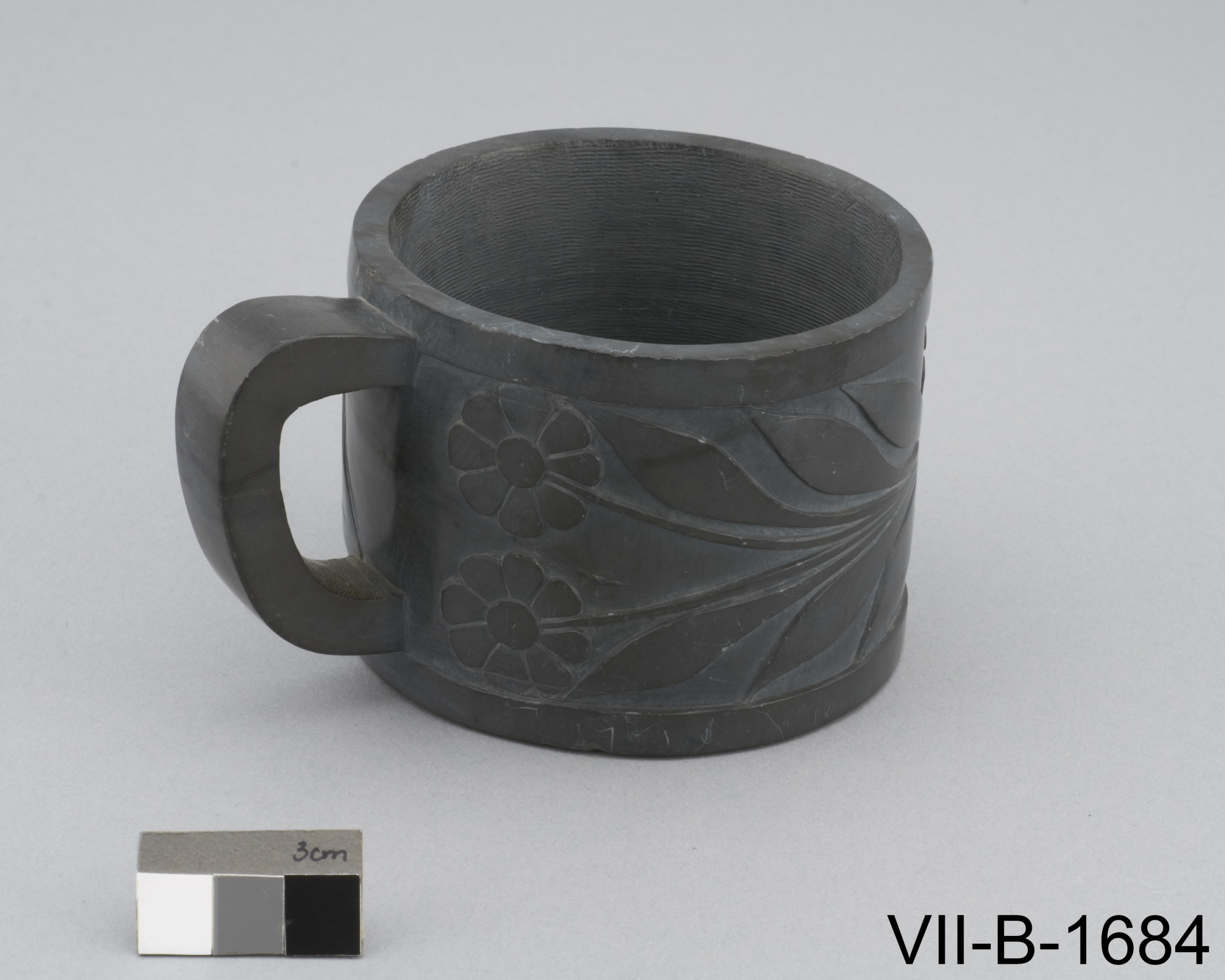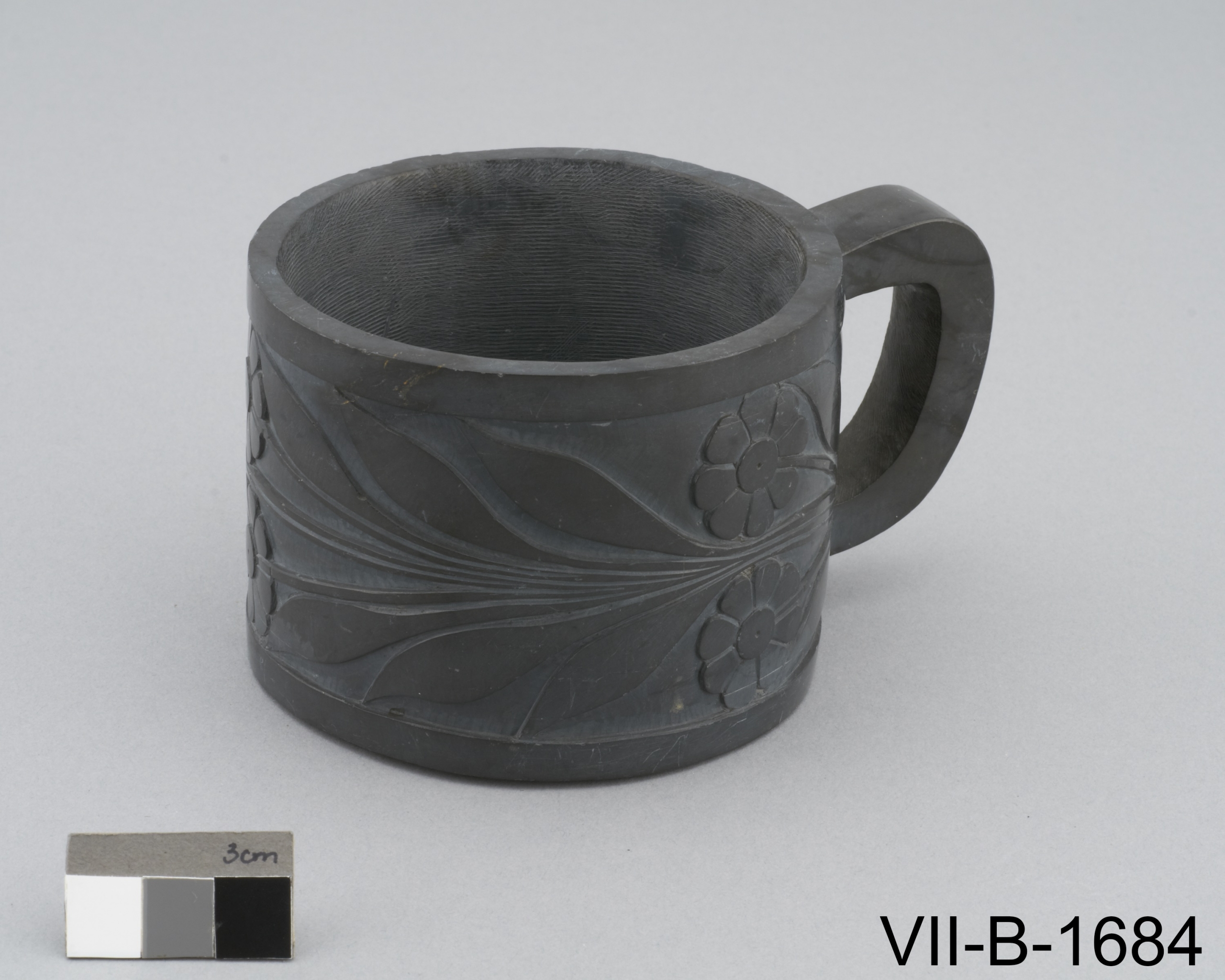Argillite Cup
Artifact
Image
Video
Audio
 Activities
Activities
THINK
Look at the designs on this hlG̱aa hlG̱ahl s’aagas sk’aas (argillite cup). Are they what you’d expect? Explain your answer. Why might this style differ from other Haida art pieces described in this package? Read the historical context below to verify your answer.
THINK
The Historical Thinking Concept of continuity and change helps us understand the complex flow of history. Cultures, events and people can both stay constant and can change over time. How does an object like this hlG̱aa hlG̱ahl s’aagas sk’aas (argillite cup) represent continuity and change?
Hint: Think about the materials used, the artistic process and the designs on the cup.
Details
 Materials
Materials - Argillite
Historical Context
Choose one of the three levels below to match your needs.
- This sk’aas (cup) was carved from a single piece of hlG̱aa hlG̱ahl s’aagas (argillite). Its style and floral designs were inspired by yaatsx̱aaydaG̱a (European) culture.
- During the 1800s, Haida artists created goods that would appeal to yaatsx̱aaydaG̱a (European) traders and merchants looking for souvenirs of their voyages.
This sk’aas (cup) was carved from a single piece of hlG̱aa hlG̱ahl s’aagas (argillite). The style of the sk’aas (cup), and the floral designs on the outside, suggest it was inspired by yaatsx̱aaydaG̱a (European) culture.
In the 19th century, some Haida artists created goods with yaatsx̱aaydaG̱a (European) motifs that would appeal to yaatsx̱aaydaG̱a (European) buyers. Just like today, visitors to Haida Gwaii in the 1800s wanted souvenirs, and Haida artists profited from this demand.
This sk’aas (cup) was carved from a single piece of hlG̱aa hlG̱ahl s’aagas (argillite). The style of the sk’aas (cup), and the floral designs on the outside, show that the artist took inspiration from yaatsx̱aaydaG̱a (European) tableware of the mid-1800s.
In the 19th century, as different visitors —from merchants to tourists — visited the coast, some Haida artists created goods with yaatsx̱aaydaG̱a (European) motifs that would appeal to yaatsx̱aaydaG̱a (European) buyers. Just like today, visitors to Haida Gwaii in the 1800s wanted souvenirs. Haida artists capitalized on the demand, producing carvings like this one on commission, for trade or for sale to yaatsx̱aaydaG̱a (European) merchants and collectors, or even to sailors wanting a reminder of their visit.
- This sk’aas (cup) was carved from a single piece of hlG̱aa hlG̱ahl s’aagas (argillite). Its style and floral designs were inspired by yaatsx̱aaydaG̱a (European) culture.
- During the 1800s, Haida artists created goods that would appeal to yaatsx̱aaydaG̱a (European) traders and merchants looking for souvenirs of their voyages.
This sk’aas (cup) was carved from a single piece of hlG̱aa hlG̱ahl s’aagas (argillite). The style of the sk’aas (cup), and the floral designs on the outside, suggest it was inspired by yaatsx̱aaydaG̱a (European) culture.
In the 19th century, some Haida artists created goods with yaatsx̱aaydaG̱a (European) motifs that would appeal to yaatsx̱aaydaG̱a (European) buyers. Just like today, visitors to Haida Gwaii in the 1800s wanted souvenirs, and Haida artists profited from this demand.
This sk’aas (cup) was carved from a single piece of hlG̱aa hlG̱ahl s’aagas (argillite). The style of the sk’aas (cup), and the floral designs on the outside, show that the artist took inspiration from yaatsx̱aaydaG̱a (European) tableware of the mid-1800s.
In the 19th century, as different visitors —from merchants to tourists — visited the coast, some Haida artists created goods with yaatsx̱aaydaG̱a (European) motifs that would appeal to yaatsx̱aaydaG̱a (European) buyers. Just like today, visitors to Haida Gwaii in the 1800s wanted souvenirs. Haida artists capitalized on the demand, producing carvings like this one on commission, for trade or for sale to yaatsx̱aaydaG̱a (European) merchants and collectors, or even to sailors wanting a reminder of their visit.
Summary
- This sk’aas (cup) was carved from a single piece of hlG̱aa hlG̱ahl s’aagas (argillite). Its style and floral designs were inspired by yaatsx̱aaydaG̱a (European) culture.
- During the 1800s, Haida artists created goods that would appeal to yaatsx̱aaydaG̱a (European) traders and merchants looking for souvenirs of their voyages.
Essential
This sk’aas (cup) was carved from a single piece of hlG̱aa hlG̱ahl s’aagas (argillite). The style of the sk’aas (cup), and the floral designs on the outside, suggest it was inspired by yaatsx̱aaydaG̱a (European) culture.
In the 19th century, some Haida artists created goods with yaatsx̱aaydaG̱a (European) motifs that would appeal to yaatsx̱aaydaG̱a (European) buyers. Just like today, visitors to Haida Gwaii in the 1800s wanted souvenirs, and Haida artists profited from this demand.
In-Depth
This sk’aas (cup) was carved from a single piece of hlG̱aa hlG̱ahl s’aagas (argillite). The style of the sk’aas (cup), and the floral designs on the outside, show that the artist took inspiration from yaatsx̱aaydaG̱a (European) tableware of the mid-1800s.
In the 19th century, as different visitors —from merchants to tourists — visited the coast, some Haida artists created goods with yaatsx̱aaydaG̱a (European) motifs that would appeal to yaatsx̱aaydaG̱a (European) buyers. Just like today, visitors to Haida Gwaii in the 1800s wanted souvenirs. Haida artists capitalized on the demand, producing carvings like this one on commission, for trade or for sale to yaatsx̱aaydaG̱a (European) merchants and collectors, or even to sailors wanting a reminder of their visit.


